
 When you see this symbol, click to read related discussion in the Forum. When you see this symbol, click to read related discussion in the Forum.
Happy Easter to everyone!
We're just back from a Spring Break road trip. If you'd like to read about it, you can do so here. -- Bill
When we got home yesterday we were surprised to see a lot of snow still hanging around from the freaky April snow storm. We also found a LOT of tree damage. Limbs broken off everywhere and we really didn't understand why. Turns out that it snowed a whole lot more here Friday night than we knew. We were in Fredericksburg Friday night and only saw about an inch. Reports from William's classmates today ranged from a foot to THREE feet. (I don't think so!) Online, I found a report of 8 inches in the Northern Neck. I guess the weight of that snow on the green spring branches was just too much. -- Bill
Seems Enon Hall is all the rage in Denmark.
Since a blogger there wrote about us a couple days ago about 10% of our total site traffic has been coming from Denmark.
Check out the site. Even if you can't read it, the photography is beautiful! The Enon Hall mention is on April 7th. And a lot of people have been commenting about us there. I think they're saying nice things, but my Danish is a little rusty.

Is that a good "Oh my God!!!!" or a bad "Oh my God!!!!"? Little hard to tell.
Actually a found an online translator that helped some. They seem to be saying nice things.
So welcome, new visitors from Denmark! -- Bill
Spring has been slow in getting here, but after the neverending nor'easter finally moved out, this weekend was beautiful. And we sure tried to make up for lost time.
We're still trying to clean up the tree damage caused by the freakish snow storm a couple weeks ago. The cedars look awful and every time I turn around I find another wrenched, twisted, and split branch high up in a tree. There are a couple trees that are going to look so bad once the damaged branches are cut out that I'm not sure it's going to be worth keeping the trees.
William and I created this pile yesterday.

Part of it is cedar branches and part of it is a few small trees that we thinned out in the front lot. It's amazing how quickly you can make a large pile.
On the positive side, our fruit trees are looking good in this their second year. The two apple trees really seemed to struggle last year, especially with deer eating the leaves, but this year they're looking much more robust. As is my Fruit Cocktail tree.

Gay's been working hard on a new flower bed for perrenials, as well as some herbs that she moved from the vegetable garden so that they're closer to the kitchen.
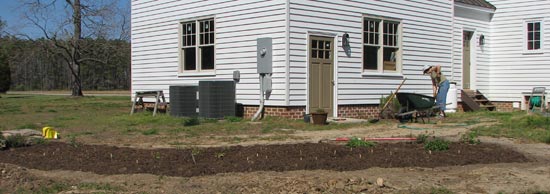
With the herbs moved, I was able to till up the vegetable garden. Last year the garden was a complete disaster. Working seven days a week on the addition, we just didn't have time to keep up with weeding the garden and it was overrun in short order. We hope to do better this year.
Looking at the picture above I can spot a million things I still need to do, like build a picket fence around the heat pump units, scrape the stickers off the garage windows, etc, etc.
And looking at this picture, can you find the "to do" list item?
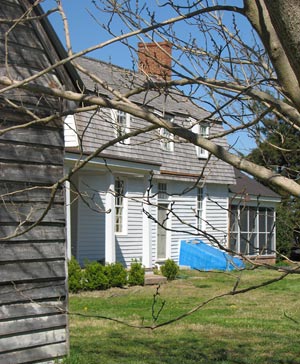
Yep, need to rebuild the bulkhead doors. They've rotted clean away.
Now that warm weather looks like it might finally be hear to stay, we can start pecking away at that list.
Boy, what a difference one year makes. I got the bill from the local lumberyard/hardware store this week and my balace due is $1.70. Same bill one year ago...$1,233.50.
But some things never change. This week I got the season's first case of poison ivy. Right on schedule.
Have you ever heard of a "butter keep?"
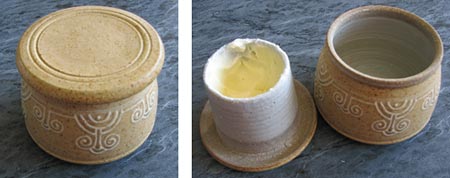
I hadn't, but apparently they've been around forever and Gay's been wanting one for at least that long. She found this one in Harper's Ferry and I must say, it's really cool.
You let a stick of butter soften and then pack it into the lid. Then you fill the base about a 1/4 full with water. Then when you replace the lid the water creates a seal around the butter, keeping it airtight so you don't need to refrigerate it. The lid is tapered so that the butter doesn't plop out into the water. And you always have soft butter on the table. Sweet! -- Bill
So, what's a "blue pig?"
A little background... A couple years ago William dug up a Civil War era spur in the backyard near the kitchen quarters. In the same spot he found a company insignia letter. The origin of these items has been a bit of a mystery.
At a shop in Fredericksburg we found an identification guide for Spurs. Using that book we identified William's spur as being a Union spur made by the William H. Horstmann Company in Philadelphia. (Worth about $200.) Union, eh? William is also thinking that the insignia letter might be from a Union hardee hat, because it has a slight curvature, whereas most insignia letters for kepis or slouch hats were flat.
Anyway...
All this leads us to wonder why we would find Union artifacts buried deep in our yard. There isn't any record of Union forces being on the ground on the Northern Neck in any number, although there were a couple of instances of Union ships firing on homes from the water as well as a couple naval skirmishes in the Bay and neighboring creeks. (Read William's history of the Civil War on the Northern Neck)
Thinking about this, I remembered a family account of a Union soldier stealing something from my great great great grandfater, Henry Straughan Hathaway. The account reads, "The Yankies stole his 'blue pig' and his body servant." Henry was captain of the home guard during the Civil War, so we can assume that the theft must have happened at a local home guard encampment. (Body servants often accompanied their masters to war as their cooks.)
But, what the heck is a "blue pig?"
I have to admit that in previously reading this account I just chalked it up to being a pig-pig. You know, "pork." But in reading this again, I doubt seriously that it was an actual pig.
Doing some online research I found that a "pig" can also be a crock or ceramic jar. That seems like a good possibility. "Pig" can also refer to iron...but why would a soldier steal something as heavy as iron? To melt it down for bullets?
Anybody have any ideas? Grant?  -- Bill -- Bill
Every once in a while somebody will do something so kind that it just blows you away. One of our readers recently did just that by sending us a beautiful sampler that she had made for us as a housewarming present!
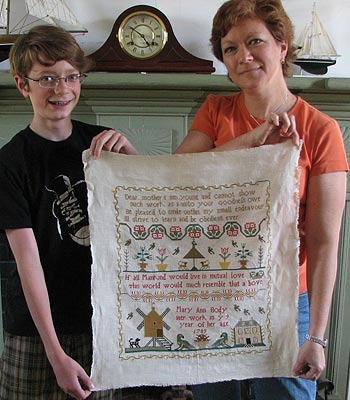
The three of us were just stunned when we opened the mailing tube and unrolled her beautiful work. We were really touched. Thanks again for your wonderful gift, Dar! We look forward to having it framed and hanging it in a place of honor at Enon Hall! -- Bill
In the 8 years since we bought Enon Hall there's one topic that I've never written about here in the Journal, although I have certainly given it a tremendous amount of thought. I haven't really been avoiding it. I just have never really known what to say. Recently a number of things have brought the topic back front and center for me, so I will attempt to explore my thoughts on the matter.
How does it feel for us to live on the land and in the house of our slaveholding ancestors?
Many Americans have ancestors who were a party to the unfathomable institution of slavery. But most of us are separated from that past by both generations and geography. We, on the other hand, are living right in the middle of it. The field slave quarters are long gone, but the kitchen quarters still stands right in our backyard, just feet from the back door. "Kitchen quarters" is a bit of a euphemism. It was the kitchen, where the domestic slaves who cooked and worked in the "big house" lived. It's a slave quarters.
My Hathaway ancestors were landholders and planters. They become prosperous and locally influential. But in a county where Robert "King" Carter was a neighbor, they certainly weren't the richest of the rich. But there's no question that what they built was built largely through the labor of slaves.
Their names are listed in estate inventories and personal property records. They had the names of people like you and me, but they had dollar values associated with them, just like tables, chairs, and farming tools. Joseph, Nan, Judith, Lucy, Mima, Rachel, Phoeby, Austen, Harry, Tom, Phillis, Charles, Peg, Hannah, Winny, James, Daniel. 17 slaves listed in a 1772 inventory, right above a "bed and furniture." Plus, generations more...earlier and later.
What kinds of lives did slaves lead at Enon Hall? Certainly not the lives they should have been leading. Certainly not the lives they would have freely chosen for themselves. Or for their children. Or grandchildren.
Southerners are famous for accounts of how their family's slaves were well-treated and happy. "Part of the family." Who would want to think or admit otherwise? The Hathaways are no different. There are stories of freed slaves coming back to the family after the war. Of well-loved former slaves buried with the white folk in the graveyard. I sure would hate to think of brutal treatment taking place here at Enon Hall. But at its best, the institution itself was inherently brutal.
In February, our state gained worldwide attention by aplogizing for its role in slavery. The reaction came down on both sides of the issue, with most poking fun at an "apology" that was due 150 years ago. What value does that apology hold today? I don't know the answer to that.
And where does that leave me? My state apologized. Should ancestors of slaveholders be apologizing too? For something my forebears last did 5 generations ago? Should I feel guilty? Should I be ashamed of Enon Hall, rather than proud?
Slavery was an abomination. America's abomination. No, the world's abomination. Last month statues were simultaneously unveiled in three cities around the world...three cities symbolic of the slave trade triangle. Richmond was one of those cities and I happened to be in Richmond at the time, working in a building right next door to the unveiling. The statue speaks to reconciliation and healing old wounds. And by unveiling these statues around the world it is acknowledged that slavery is part of our shared history. I like that sentiment. And I like the healing part. Slavery was a horror. And a horrible price was paid to end it.
I'm proud of my ancestors. I don't think that pride comes from agreeing with everything they did. I think that pride comes from being able to say that I know who they were, where they lived, how they lived. So many people don't know a thing about their family beyond their grandparents. I'm proud to have so much information. It gives me roots. It gives my family a story. Their story is only a part of my story. I'm not responsible for their story. I'm responsible for mine.
I have no power to offer a meaningful apology for something that I didn't do. I can only acknowledge that it was wrong. But we all already know that.
But I can do something else. I can preserve the evidence. In our case, that's the kitchen quarters and the little information that we have through research.
Under our watch, the kitchen quarters will never become anything else. It might make a cool studio, or office, or guest house. But we can't turn it into something else. It needs to remain true to its history. The Enon Hall story can't be told without it. My family's story can't be told without it. And, not to sound corny, America's story can't be told without it. It's a conversation piece where conversation is still sorely needed. And it's a tribute to those who lived and labored here through no choice of their own.
Often a visitor here will casually refer to that building as a "shed." I always correct them. To not recognize it for what it is is, to me, to disrespect and trivialize all of those who lived and worked inside its walls.
I wish I knew more about slavery here at Enon Hall. I wish I had more answers. I wish I knew where the slaves were buried. How they were treated. How they felt. Where their descendants are today. I can only imagine.
But it's good to imagine. It makes us think about that which we can't personally remember. And remember that which shouldn't be forgotten.  -- Bill -- Bill
I still haven't hung any of our collection of 18th and 19th century interior doors, but I'm getting mentally geared up for that project.
One of the questions related to this has always been what to do about the finish of these old doors. Right now they have an awesome patina of old chipped paint. If we removed all that and painted them, they'd lose 90% of their charm. But how would a chipped paint door look hung in a nicely painted doorway? A doorway that's painted in colors that have no relation to the existing colors of the old door?
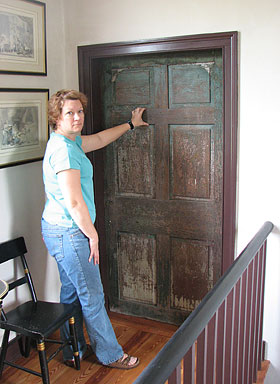
Turns out, it looks really cool!
This is the door to William's room. (Gay's holding it in place so it doesn't fall over while I take the photo.) So I think the plan is to do as little to them as possible. A few of the doors need to be squared up, so I'll have to do something to blend in freshly cut edges.
Lucy cornered a black snake today, circling it and barking wildly. Always keeping just enough distance. What was funny was that the snake was in the process of shedding its skin and when it finally got away from Lucy and headed under the porch, it left behind its skin. Lucy was a bit puzzled by this and continued to bark at the skin. Then she got brave and actually grabbed it and tossed it in the air. Then she tore it into smaller bits. When we came out she showed us proudly. "Yeah, he got away. But not before I stole his clothes!" -- Bill
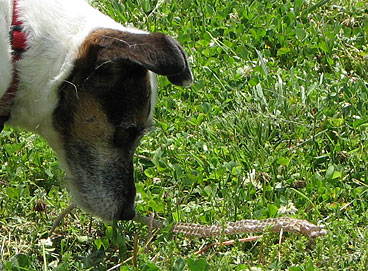
|
 When you see this symbol, click to read related discussion in the Forum.
When you see this symbol, click to read related discussion in the Forum. 








